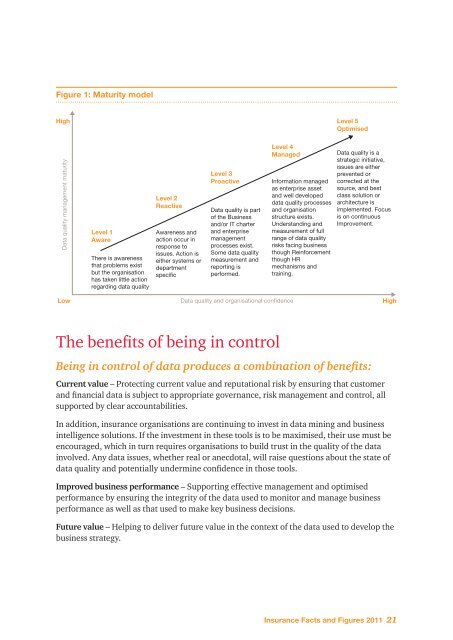PwC Insurance Facts and Figures 2011 - PricewaterhouseCoopers
PwC Insurance Facts and Figures 2011 - PricewaterhouseCoopers
PwC Insurance Facts and Figures 2011 - PricewaterhouseCoopers
Create successful ePaper yourself
Turn your PDF publications into a flip-book with our unique Google optimized e-Paper software.
Figure 1: Maturity model<br />
High<br />
Level 5<br />
Optimised<br />
Data quality management maturity<br />
Level 1<br />
Aware<br />
There is awareness<br />
that problems exist<br />
but the organisation<br />
has taken little action<br />
regarding data quality<br />
Level 2<br />
Reactive<br />
Awareness <strong>and</strong><br />
action occur in<br />
response to<br />
issues. Action is<br />
either systems or<br />
department<br />
specific<br />
Level 3<br />
Proactive<br />
Data quality is part<br />
of the Business<br />
<strong>and</strong>/or IT charter<br />
<strong>and</strong> enterprise<br />
management<br />
processes exist.<br />
Some data quality<br />
measurement <strong>and</strong><br />
reporting is<br />
performed.<br />
Level 4<br />
Managed<br />
Information managed<br />
as enterprise asset<br />
<strong>and</strong> well developed<br />
data quality processes<br />
<strong>and</strong> organisation<br />
structure exists.<br />
Underst<strong>and</strong>ing <strong>and</strong><br />
measurement of full<br />
range of data quality<br />
risks facing business<br />
though Reinforcement<br />
though HR<br />
mechanisms <strong>and</strong><br />
training.<br />
Data quality is a<br />
strategic initiative,<br />
issues are either<br />
prevented or<br />
corrected at the<br />
source, <strong>and</strong> best<br />
class solution or<br />
architecture is<br />
implemented. Focus<br />
is on continuous<br />
Improvement.<br />
Low<br />
Data quality <strong>and</strong> organisational confidence<br />
High<br />
The benefits of being in control<br />
Being in control of data produces a combination of benefits:<br />
Current value – Protecting current value <strong>and</strong> reputational risk by ensuring that customer<br />
<strong>and</strong> financial data is subject to appropriate governance, risk management <strong>and</strong> control, all<br />
supported by clear accountabilities.<br />
In addition, insurance organisations are continuing to invest in data mining <strong>and</strong> business<br />
intelligence solutions. If the investment in these tools is to be maximised, their use must be<br />
encouraged, which in turn requires organisations to build trust in the quality of the data<br />
involved. Any data issues, whether real or anecdotal, will raise questions about the state of<br />
data quality <strong>and</strong> potentially undermine confidence in those tools.<br />
Improved business performance – Supporting effective management <strong>and</strong> optimised<br />
performance by ensuring the integrity of the data used to monitor <strong>and</strong> manage business<br />
performance as well as that used to make key business decisions.<br />
Future value – Helping to deliver future value in the context of the data used to develop the<br />
business strategy.<br />
<strong>Insurance</strong> <strong>Facts</strong> <strong>and</strong> <strong>Figures</strong> <strong>2011</strong> 21
















